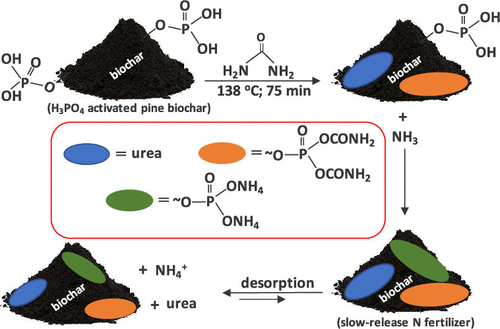当前位置:
X-MOL 学术
›
ACS Sustain. Chem. Eng.
›
论文详情
Our official English website, www.x-mol.net, welcomes your feedback! (Note: you will need to create a separate account there.)
Enhancing Biochar as Scaffolding for Slow Release of Nitrogen Fertilizer
ACS Sustainable Chemistry & Engineering ( IF 8.4 ) Pub Date : 2021-06-08 , DOI: 10.1021/acssuschemeng.1c02267 Santanu Bakshi 1 , Chumki Banik 1 , David A. Laird 2 , Ryan Smith 1 , Robert C. Brown 1
ACS Sustainable Chemistry & Engineering ( IF 8.4 ) Pub Date : 2021-06-08 , DOI: 10.1021/acssuschemeng.1c02267 Santanu Bakshi 1 , Chumki Banik 1 , David A. Laird 2 , Ryan Smith 1 , Robert C. Brown 1
Affiliation

|
Nitrogen (N) is an essential macronutrient for plant growth; however, excessive use of N fertilizers and complexities of the N cycle in soil cause negative environmental impacts. This imposes several challenges in controlling the N availability timing and losses. The objective of this study was to develop a biochar-based slow-release fertilizer (SRF) to reduce N loss and increase N use efficiency in crop production. We provided a laboratory-based assessment of several H3PO4 activated (5 and 15%) biochar-based SRFs, produced from different combinations of biochar to urea (1:2, 1:3, 1:4, and 1:6), calcium lignosulfonate (5%), and paraffin wax (10%). Characterization analyses (SEM–EDS, XRD, FTIR, and XPS) of developed SRFs suggest successful urea grafting onto biochar through both the urea amine N and carbonyl C═O modes, without urea crystal structure disruption. The SRFs were more efficient than uncoated urea (control): (1) urea released in aqueous medium was 61–90% in 4320 min for the SRFs versus 99.6% in 12 min for the control; (2) cumulative N leached from soil columns was 68–71% after 41 leaching events for SRF versus 99.9% after four leaching events for the control; and (3) NH3-N volatilization from soil was 0.2–0.9% for the SRFs versus 2% for the control. Inclusively, our results suggest that the developed SRFs are effective for reducing N loss from soil and provide larger quantities of NH4+-N to plants for a longer time (improved N use efficiency). We attribute this to that the developed SRFs are optimal for synchronizing with plant N uptake for providing better sustainability in modern agriculture.
中文翻译:

加强生物炭作为缓释氮肥的支架
氮 (N) 是植物生长必不可少的常量营养素;然而,过度使用氮肥和土壤中氮循环的复杂性会对环境造成负面影响。这在控制 N 可用性时序和损耗方面带来了一些挑战。本研究的目的是开发一种基于生物炭的缓释肥料 (SRF),以减少氮损失并提高作物生产中的氮利用效率。我们对几种 H 3 PO 4进行了基于实验室的评估活化(5% 和 15%)基于生物炭的 SRF,由生物炭与尿素(1:2、1:3、1:4 和 1:6)、木质素磺酸钙(5%)和石蜡的不同组合制成( 10%)。已开发的 SRF 的表征分析(SEM-EDS、XRD、FTIR 和 XPS)表明,尿素通过尿素胺 N 和羰基 C=O 模式成功接枝到生物炭上,而不会破坏尿素晶体结构。SRFs 比未包衣的尿素(对照)更有效:(1)SRFs 在水性介质中释放的尿素在 4320 分钟内为 61-90%,而对照在 12 分钟内为 99.6%;(2) SRF 在 41 次浸出事件后从土壤柱中的累积 N 浸出率为 68-71%,而对照在 4 次浸出事件后为 99.9%;(3) NH 3SRF 土壤中的 -N 挥发为 0.2-0.9%,而对照为 2%。总之,我们的结果表明,开发的 SRF 可有效减少土壤中的 N 损失,并在更长的时间内为植物提供更大量的 NH 4 + -N(提高 N 的利用效率)。我们将此归因于开发的 SRF 最适合与植物 N 吸收同步,从而为现代农业提供更好的可持续性。
更新日期:2021-06-21
中文翻译:

加强生物炭作为缓释氮肥的支架
氮 (N) 是植物生长必不可少的常量营养素;然而,过度使用氮肥和土壤中氮循环的复杂性会对环境造成负面影响。这在控制 N 可用性时序和损耗方面带来了一些挑战。本研究的目的是开发一种基于生物炭的缓释肥料 (SRF),以减少氮损失并提高作物生产中的氮利用效率。我们对几种 H 3 PO 4进行了基于实验室的评估活化(5% 和 15%)基于生物炭的 SRF,由生物炭与尿素(1:2、1:3、1:4 和 1:6)、木质素磺酸钙(5%)和石蜡的不同组合制成( 10%)。已开发的 SRF 的表征分析(SEM-EDS、XRD、FTIR 和 XPS)表明,尿素通过尿素胺 N 和羰基 C=O 模式成功接枝到生物炭上,而不会破坏尿素晶体结构。SRFs 比未包衣的尿素(对照)更有效:(1)SRFs 在水性介质中释放的尿素在 4320 分钟内为 61-90%,而对照在 12 分钟内为 99.6%;(2) SRF 在 41 次浸出事件后从土壤柱中的累积 N 浸出率为 68-71%,而对照在 4 次浸出事件后为 99.9%;(3) NH 3SRF 土壤中的 -N 挥发为 0.2-0.9%,而对照为 2%。总之,我们的结果表明,开发的 SRF 可有效减少土壤中的 N 损失,并在更长的时间内为植物提供更大量的 NH 4 + -N(提高 N 的利用效率)。我们将此归因于开发的 SRF 最适合与植物 N 吸收同步,从而为现代农业提供更好的可持续性。



























 京公网安备 11010802027423号
京公网安备 11010802027423号